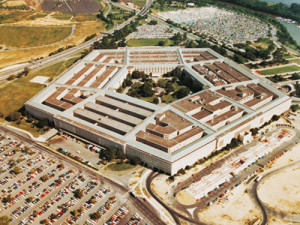
Organizational changes on DoD wishlist for NDAA
The Defense Department is looking at changing the roles of the combatant commands and Joint Chiefs of Staff .
The Defense Department might recommend making some major changes to the way it operates globally over the next few years.
Defense Secretary Ash Carter said he may be making recommendations to change the roles of the combatant commands and the Joint Chiefs of Staff for the 2017 defense authorization bill.
The suggestions come as Carter continued to push Congress to end sequestration.
“Goldwater-Nichols was a great thing. It did a lot of very important things. It did establish the combatant commanders’ jointness and lots of other things; however, that was an era before there was as big of a need as there is now for transregional and transfunctional integration,” Carter said during a March 18 POLITICO event in Washington. “That’s an area that couldn’t have been foreseen at the time.”
The Goldwater-Nichols Act reformed DoD in the 1980s.
Carter also lobbied for a bigger role for the Joint Chiefs of Staff.
During a March 17 Senate Armed Services Committee, Carter said he would like the Joint Chiefs of Staff to act as information aggregators for the Defense Secretary.
“I would like to strengthen the role of the Joint Chiefs of Staff and the chairman,” Carter said. “ Because different [combatant commands] see different things in their regions, they are all deeply expert in their own regions, but somebody needs to put it all together and give me advice about that: how to synchronize all those forces. I look to the Chairman and the Joint Staff for that. I’d like to get to — for them to have more capability and authority to do so.”
Carter said on March 18 he wouldn’t want to give the Joint Chiefs of Staff any authority that would detract from their ability to give independent military advice. Carter also said he opposes adding the Joint Chiefs to the chain of command.
Military officials said previously that threats like the Islamic State create a need for more transregional and transfunctional military organization. That stems from conflicts no long taking place in just one region of the world.
The current combatant command system separates the world into six geographic regions with their own commanders. The other combatant commands are called functional commands and consist of U.S. Strategic Command, U.S. Special Operations Command and U.S. Transportation Command. The first place where those commands integrate is at the Defense Secretary’s office.
In December, Chairman of the Joint Chiefs of Staff Gen. Joseph Dunford said there is a need for a staff to reflect the perspective of all the combatant commanders.
That may be a hard sell for Congress even if the Joint Chiefs take that role, especially if it means the hiring of new staff.
Congress has been trying to cut back on the staff within the Pentagon and both the Joint and the combatant commands have targets on their backs.
In December, former DoD Undersecretary for Policy Michele Flournoy told the Senate Armed Services Committee the Joint Staff has burgeoned to more than 4,000 employees, the Office of the Secretary of Defense to 5,000 and the combatant commands have grown to more than 38,000.
They “are ripe for a real scrub in terms of the breadth of their functions and the level of duplication with the joint staff and with OSD,” Flournoy said.
She added that DoD headquarters and agencies staff is now at 240,000 without contractors, which costs $133 billion a year.
Congress and DoD have made moves already to cut some of the headquarters staff.
The 2016 Defense authorization act has a provision to cut 25 percent of its workforce over the next five years. That will cut about $10 billion by 2018.
DoD saw the signs and directed the cut with or without a congressional requirement in September.
“We anticipate Congress will require a 25 percent reduction in the funding of DoD headquarters in lieu of the 20 percent requirement previously established by the department,” a September memo signed by Deputy Defense Secretary Bob Work stated. “Even if Congress fails to act, the department needs the savings that will be achieved through this reduction to fund higher priority requirements in support of the warfighter and to address underfunded strategic needs.”
Sequestration rears its head
It’s especially salient that DoD and Congress are trying to save money on staff, considering sequestration is planned to return in 2018.
Carter told the Senate Armed Services Committee the budget caps were the greatest threat to DoD’s defense strategy.
Carter isn’t the only one to say so either. The vice chiefs of all four military services told the Senate Armed Services Readiness Subcommittee earlier this week that sequestration was their biggest worry.
But, the caps are not the only deficit DoD has to worry about. The department is already between $11 billion and $17 billion in the hole for 2017.
That shortfall is being made up in risks to military construction, maintenance and equipment, things DoD said were essential last year.
Even if Congress can somehow come to a deal to end sequestration once and for all, DoD is still going to need big plus ups to get the funds it says it needs to use in future years.
DoD’s modernization bow wave is expected to hit in the 2020s. The wave is costs to upgrade things like the nuclear triad and other equipment.
If sequestration returns, DoD will be under its planned budget by about $100 billion over five years, said Kathrine Blakeley, a research fellow at the Center for Strategic and Budgetary Assessments.
If sequestration is averted, Congress will have to figure out how it can add at least $20 billion to an already nearly $600 billion dollar defense budget every year.
Copyright © 2024 Federal News Network. All rights reserved. This website is not intended for users located within the European Economic Area.
Scott Maucione is a defense reporter for Federal News Network and reports on human capital, workforce and the Defense Department at-large.
Follow @smaucioneWFED




